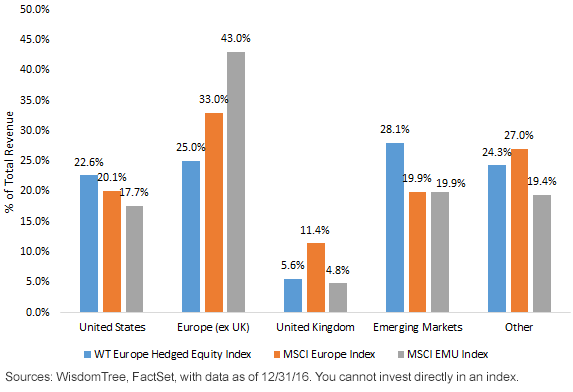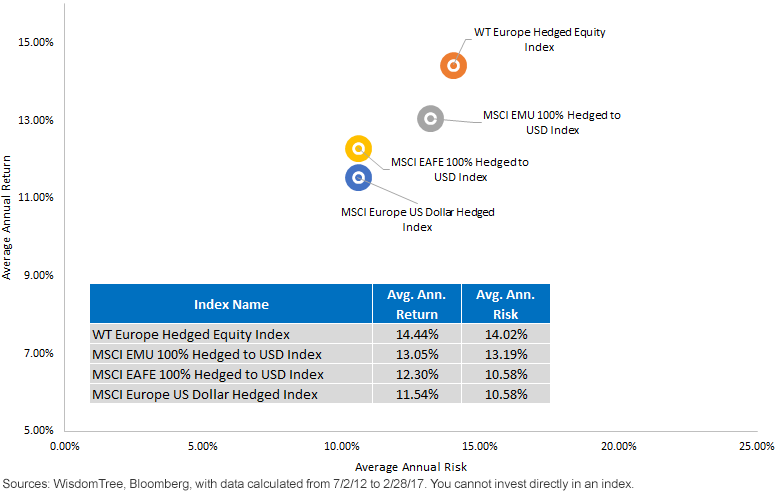European Exporters—Where Are the Risks?


As of this writing, the market was still adjusting to the new administration of President Donald Trump. It is difficult to form reasoned conclusions about how assets should be allocated, given the number of different policy concerns yet to be specified and decided.
Import Tariffs = Great Headline, Frightening Policy
One thing we’re hearing a lot about is tariffs or a border adjustment tax. With Trump’s protectionist rhetoric, it would seem we’re heading to some type of additional taxes on imports. While questions (When? With which specific countries? And with which specific details or provisions?) remain to be figured out, it’s worth analyzing the WisdomTree Europe Hedged Equity Index with this thought in mind, as well as considering the balance of other risks that may be on the table.
Valuation: The Starting Point
Looking at the estimated price-to-earnings (P/E) ratio of the WisdomTree Europe Hedged Equity, MSCI EMU and MSCI Europe Indexes, there is a discount of approximately 16% to 17% compared to that of the S&P 500 Index.1 With U.S. markets at or near record highs, we’re seeing more and more investors considering taking a portion of these profits and thinking about markets outside the U.S.
Relative valuation, therefore, is the point that begins the European equity conversation.
Risk #1: A Trump Import Tax Plan
Given concerns about Trump’s import tax threats, an important point of comparison among European-focused investments regards how much revenue is actually coming from the United States.
Tilting toward Exporters Appeared to Place Bigger Relative Emphasis on Emerging Markets

- Nearly 9% More Revenue from Emerging Markets: Besides shifting the focus away from Europe, the biggest tilt to exporters from Europe was nearly 9% more revenue coming from emerging markets with the WisdomTree Europe Hedged Equity Index than either the MSCI Europe or MSCI EMU Indexes. Most of this difference came from approximately 2% to 3% more revenue from Brazil, 1.5% to 2% more from China and 2% more from Mexico.
- Approximately 2.5% to 5% More Exposure to Revenues from the U.S.: As can be seen, there is greater emphasis on revenue from the U.S., but there is less relative difference there than what we noted for emerging markets.
- Similar Revenues from the UK: With the British pound trading at a level of $1.24 as of this writing,2 it raises an important question relating to any exports to the UK becoming more expensive. The WisdomTree Europe Hedged Equity Index and MSCI EMU Index had a very similar level of revenue from the UK. The MSCI Europe Index had approximately twice as much given that it is the only Index of the three shown with constituents from within the UK.
- Exporters Are in the Market Capitalization-Weighted Benchmarks: We should also note that the strategy of “tilting toward exporters” does not focus on smaller, more esoteric European companies. The weight of the commonly held firms in the MSCI EMU Index is almost 50% and almost 25% in the MSCI Europe Index, notably lower due to large markets such as the United Kingdom and Switzerland not trading in euros and not being eligible for inclusion in the WisdomTree Europe Hedged Equity Index.3
This revenue analysis shows that the true risk to an export-oriented approach may well be Europe’s relationship with emerging markets rather than with the United States.
Risk #2: Tilting toward Exporters Represents a Double, Riskier “Bet” on Currency
In the world of currency hedging, there are nearly as many rumors as there are competitors. In our opinion, it’s important to always return to the live data to indicate what it shows.
Live Risk vs. Return Analysis
With approximately four and a half years of live history on the books for the WisdomTree Europe Hedged Equity Index, we can evaluate the risk versus return trade-offs demonstrated in real time compared to other hedged indexes focused on Europe.
- WisdomTree Europe Hedged Equity Index: From inception to February 28, 2017, average annual returns were 14.44%, while average annual risk was 14.02%.
- MSCI EMU 100% Hedged to USD Index: Over this same period, average annual returns were 13.05%, while average annual risk was 13.19%.
- MSCI Europe US Dollar Hedged Index: Finally, this Index displayed average annual returns of 11.54%, with average annual risk of 10.58%.
On a cumulative basis, that means that the WisdomTree Europe Hedged Equity Index ended the period approximately 10% ahead of the MSCI EMU 100% Hedged to USD Index, and 21% ahead of the MSCI Europe US Dollar Hedged Index. “Risk” covers both upward and downward movements, it is important to recall.
Overall Risk/Return Compared to Market Capitalization-Weighted Benchmarks

Larger Risks to Europe
The WisdomTree European exporter Index delivered similar levels of risk, with moderately higher returns over this period. The evidence doesn’t support statements that tilting toward exporters dramatically increases the risk of a strategy focused on European equities, and if anything we think chances are that it reduces risk going forward. The larger risks to Europe as we see them could include:
- Whether or not the issues in the Financials sector of various countries (most recently Italy) are truly behind us. Tilting toward exporters has historically led to an under-weight in the Financials sector compared to market capitalization-weighted approaches.
- Whether or not Brexit will be smoothly executed with minimal disruption to the business community. Investors will need to determine whether they prefer to include the UK or to focus the eurozone only for the way in which they decide to capture their European equities.
- Whether different election results in 2017 will ultimately prove supportive to markets and result in more euro currency weakness. Tilting toward exporters does emphasize any incremental boost to earnings that may come from such weakness, but it’s important to further note that market capitalization-weighted exposures also do tend to include the largest of these multinational companies.
Once investors decide whether the valuation of European equities compared to U.S. equities warrants an allocation, we believe tilting toward exporters provides European equity exposure that looks well positioned to weather the happenings of Europe in 2017.
1Source: Bloomberg, with data as of 2/28/17.
2Source: Bloomberg, with data as of 2/28/17.
3Source: Bloomberg, with data as of 2/3/17.
Important Risks Related to this Article
Hedging can help returns when a foreign currency depreciates against the U.S. dollar, but can hurt when the foreign currency appreciates against the U.S. dollar.
Investments focused in Europe increase the impact of events and developments associated with the region, which can adversely affect performance.

Christopher Gannatti began at WisdomTree as a Research Analyst in December 2010, working directly with Jeremy Schwartz, CFA®, Director of Research. In January of 2014, he was promoted to Associate Director of Research where he was responsible to lead different groups of analysts and strategists within the broader Research team at WisdomTree. In February of 2018, Christopher was promoted to Head of Research, Europe, where he was based out of WisdomTree’s London office and was responsible for the full WisdomTree research effort within the European market, as well as supporting the UCITs platform globally. In November 2021, Christopher was promoted to Global Head of Research, now responsible for numerous communications on investment strategy globally, particularly in the thematic equity space. Christopher came to WisdomTree from Lord Abbett, where he worked for four and a half years as a Regional Consultant. He received his MBA in Quantitative Finance, Accounting, and Economics from NYU’s Stern School of Business in 2010, and he received his bachelor’s degree from Colgate University in Economics in 2006. Christopher is a holder of the Chartered Financial Analyst Designation.

